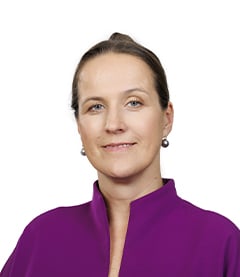-
Other audit services
We help clients with the application and use of foreign financial aid of EU and other funds and help prepare financial reports.
-
Audit calculator
The calculator will answer if the company's sales revenue, assets or number of employees exceed the limit of an inspection or audit.
-
Payroll and related services
We perform payroll accounting for companies whether they employ a few or hundreds of employees.
-
Tax accounting
Grant Thornton Baltic's experienced tax specialists support accountants and offer reasonable and practical solutions.
-
Reporting
We prepare annual reports in a timely manner. We help to prepare management reports and various mandatory reports.
-
Consolidation of financial statements
Our experienced accountants and advisors help you prepare consolidation tables and make the consolidation process more efficient.
-
Consultancy and temporary staff
Our experienced specialists advise on more complex accounting transactions, rectify poor historic accounting, and offer the temporary replacement of an accountant.
-
Outsourced CFO service
Our CFO service is suitable for companies of all sizes and in all industries. We offer services to our clients in the required amount and competences.
-
Assessment of accounting processes
We help companies to implement accounting practices that are in compliance with local and international standards.
-
Accounting services for small businesses
We offer affordable service for small businesses. We help organize processes as smartly and cost-effectively as possible.
-
Cryptocurrency accounting
We keep up with blockchain technology to serve and advise crypto companies. We are supported by a network of colleagues in 130 countries.
-
Trainings and seminars
Our accountants have experience in all matters related to accounting and reporting. We offer our clients professional training according to their needs.

-
Business advisory
We offer legal support to both start-ups and expanding companies, making sure that all legal steps are well thought out in detail.
-
Fintech advisory
Our specialists advise payment institutions, virtual currency service providers and financial institutions.
-
Corporate advisory
We advise on legal, tax and financial matters necessary for better management of the company's legal or organizational structure.
-
Transaction advisory
We provide advice in all aspects of the transaction process.
-
Legal due diligence
We thoroughly analyze the internal documents, legal relations, and business compliance of the company to be merged or acquired.
-
In-house lawyer service
The service is intended for entrepreneurs who are looking for a reliable partner to solve the company's day-to-day legal issues.
-
The contact person service
We offer a contact person service to Estonian companies with a board located abroad.
-
Training
We organize both public trainings and tailor made trainings ordered by clients on current legal and tax issues.
-
Whistleblower channel
At Grant Thornton Baltic, we believe that a well-designed and effective reporting channel is an efficient way of achieving trustworthiness.

-
Business model or strategy renewal
In order to be successful, every company, regardless of the size of the organization, must have a clear strategy, ie know where the whole team is heading.
-
Marketing and brand strategy; creation and updating of the client management system
We support you in updating your marketing and brand strategy and customer management system, so that you can adapt in this time of rapid changes.
-
Coaching and development support
A good organizational culture is like a trump card for a company. We guide you how to collect trump cards!
-
Digital services
Today, the question is not whether to digitize, but how to do it. We help you develop and implement smart digital solutions.
-
Sales organisation development
Our mission is to improve our customers' business results by choosing the right focuses and providing a clear and systematic path to a solution.
-
Business plan development
A good business plan is a guide and management tool for an entrepreneur, a source of information for financial institutions and potential investors to make financial decisions.
-
Due diligence
We perform due diligence so that investors can get a thorough overview of the company before the planned purchase transaction.
-
Mergers and acquisitions
We provide advice in all aspects of the transaction process.
-
Valuation services
We estimate the company's market value, asset value and other asset groups based on internationally accepted methodology.
-
Forensic expert services
Our experienced, nationally recognized forensic experts provide assessments in the economic and financial field.
-
Business plans and financial forecasts
The lack of planning and control of cash resources is the reason often given for the failure of many businesses. We help you prepare proper forecasts to reduce business risks.
-
Outsourced CFO service
Our CFO service is suitable for companies of all sizes and in all industries. We offer services to our clients in the required amount and competences.
-
Reorganization
Our experienced reorganizers offer ways to overcome the company's economic difficulties and restore liquidity in order to manage sustainably in the future.
-
Restructuring and reorganisation
We offer individual complete solutions for reorganizing the structure of companies.
-
Corporate taxation
We advise on all matters related to corporate taxation.
-
Value added tax and other indirect taxes
We have extensive knowledge in the field of VAT, excise duties and customs, both on the national and international level.
-
International taxation
We advise on foreign tax systems and international tax regulations, including the requirements of cross-border reporting.
-
Transfer pricing
We help plan and document all aspects of a company's transfer pricing strategy.
-
Taxation of transactions
We plan the tax consequences of a company's acquisition, transfer, refinancing, restructuring, and listing of bonds or shares.
-
Taxation of employees in cross-border operations
An employee of an Estonian company abroad and an employee of a foreign company in Estonia - we advise on tax rules.
-
Tax risk audit
We perform a risk audit that helps diagnose and limit tax risks and optimize tax obligations.
-
Representing the client in Tax Board
We prevent tax problems and ensure smooth communication with the Tax and Customs Board.
-
Taxation of private individuals
We advise individuals on personal income taxation issues and, represent the client in communication with the Tax and Customs Board.
-
Pan-Baltic tax system comparison
Our tax specialists have prepared a comparison of the tax systems of the Baltic countries regarding the taxation of companies and individuals.
-
Internal audit
We assist you in performing the internal audit function, performing internal audits and advisory work, evaluating governance, and conducting training.
-
Internal Audit in the Financial Services Sector
We provide internal audit services to financial sector companies. We can support the creation of an internal audit function already when applying for a sectoral activity license.
-
Audit of projects
We conduct audits of projects that have received European Union funds, state aid, foreign aid, or other grants.
-
Prevention of money laundering
We help to prepare a money laundering risk assessment and efficient anti-money laundering procedures, conduct internal audits and training.
-
Risk assessment and risk management
We advise you on conducting a risk assessment and setting up a risk management system.
-
Custom tasks
At the request of the client, we perform audits, inspections and analyzes with a specific purpose and scope.
-
External Quality Assessment of the Internal Audit Activity
We conduct an external evaluation of the quality of the internal audit or provide independent assurance on the self-assessment.
-
Whistleblowing and reporting misconduct
We can help build the whistleblowing system, from implementation, internal repairs and staff training to the creation of a reporting channel and case management.
-
Information security management
We provide you with an information security management service that will optimise resources, give you an overview of the security situation and ensure compliance with the legislation and standards.
-
Information security roadmap
We analyse your organisation to understand which standards or regulations apply to your activities, identify any gaps and make proposals to fix them.
-
Internal audit of information security
Our specialists help detect and correct information security deficiencies by verifying an organization's compliance with legislation and standards.
-
Third party management
Our specialists help reduce the risks associated with using services provided by third parties.
-
Information security training
We offer various training and awareness building programmes to ensure that all parties are well aware of the information security requirements, their responsibilities when choosing a service provider and their potential risks.
-
Digital Operational Resilience Act (DORA)
We will help you create a DORA implementation model that meets your company's needs and ensures that you meet the January 2025 deadline.

-
ESG advisory
We help solve issues related to the environment, social capital, employees, business model and good management practices.
-
ESG audit
Our auditors review and certify sustainability reports in line with international standards.
-
Sustainable investments
We help investors conduct analysis of companies they’re interested in, examining environmental topics, corporate social responsibility and good governance practices.
-
Sustainable tax behaviour
Our international taxation specialists define the concept of sustainable tax behaviour and offer services for sustainable tax practices.
-
ESG manager service
Your company doesn’t necessarily need an in-house ESG manager. This role can also be outsourced as a service.

-
Recruitment services – personnel search
We help fill positions in your company with competent and dedicated employees who help realize the company's strategic goals.
-
Recruitment support services
Support services help to determine whether the candidates match the company's expectations. The most used support services are candidate testing and evaluation.
-
Implementation of human resource management processes
We either assume a full control of the launch of processes related to HR management, or we are a supportive advisory partner for the HR manager.
-
Audit of HR management processes
We map the HR management processes and provide an overview of how to assess the health of the organization from the HR management perspective.
-
HR Documentation and Operating Model Advisory Services work
We support companies in setting up HR documentation and operational processes with a necessary quality.
-
Employee Surveys
We help to carry out goal-oriented and high-quality employee surveys. We analyse the results, make reports, and draw conclusions.
-
HR Management outsourcing
We offer both temporary and permanent/long-term HR manager services to companies.

-
Digital strategy
We help assess the digital maturity of your organization, create a strategy that matches your needs and capabilities, and develop key metrics.
-
Intelligent automation
We aid you in determining your business’ needs and opportunities, as well as model the business processes to provide the best user experience and efficiency.
-
Business Intelligence
Our team of experienced business analysts will help you get a grip on your data by mapping and structuring all the data available.
-
Cybersecurity
A proactive cyber strategy delivers you peace of mind, allowing you to focus on realising your company’s growth potential.
-
Innovation as a Service
On average, one in four projects fails and one in two needs changes. We help manage the innovation of your company's digital solutions!


Autorid: Kristel Tiits, Heliis Liiv
From 1 April 2022, when the system for taking child leave will change in the Employment Contracts Act, all parents of children under 14 years of age will be entitled to 10 working days of paid child leave per child under 14. It should be borne in mind, however, that these 10 working days are not allotted for each year but can be taken once starting from the expiry of the parental benefit until the child reaches the age of 14. During the calendar year when the child turns 14, the child leave is granted regardless of whether their birthday is before or after the leave.
While each parent previously had the right to take altogether three to six days of leave per year depending on the age of the child, the amendment will bring more equality between the parents, as from 1 April, both parents will have the equal rights of 10 working days of child leave, leave will no longer be calculated on a per-year basis. In other words, in families raising one child, the parents will receive a total of 20 working days’ of child leave (10 working days each) until the child reaches the age of 14. If there is more than one child in the family, both parents will receive 10 days of leave per child – so for example if there are four children in the family, each parent will receive a total of 40 days of leave. However, if a parent wishes to use all of their child leave days in the same year and they have more than three children, the maximum days of leave that can be used in a specific year is 30. The leave can be used in one instalment or on individual days until the child turns 14; the accounting for child leave on per-year basis will be discontinued. Legal guardians or foster parents are also eligible to use the child leave.
Compared to the previous system, a key change for parents is that now both parents will have individual rights to take the leave, which the parent can use at their discretion, taking into account the child’s needs. The amendment rules out a situation where the father wants to use the child leave, but it turns out that the mother has already used up the days of leave.
Accounting for child leave to start as of the end of the parental benefit
The right of a parent for 10 days of leave starts from the date of expiry of the parental benefit until the child turns 14 years of age (including the entire calendar year in which the child turned 14). The amount of the child leave benefit paid per calendar day is 50% of the daily rate of the parental benefit specified in the Family Benefits Act but shall not be less than the amount of parental benefit for one calendar day calculated based on the minimum income established by the Government of the Republic.
The Ministry of Social Affairs presented following example: if a person’s taxable income for social tax purposes in a given calculation period was 1200 euros, their daily child leave benefit in 2022 will be 30.78 euros. Based on the Family Benefits Act, the calculation would be as follows: the daily rate of the child leave benefit would be 1200 divided by 30 = 40 and 50% of that is 20 euros; however, according to the law the daily rate of child leave benefit cannot be lower than the daily minimum wage. The minimum wage in 2022 is 654 euros and the daily minimum is thus 30.78 euros. However, if a person’s income in the calculation period is totalled 3000 euros, their child leave benefit for one day would be 3000 divided by 30 = 100, of which 50% is 50 euros. The examples cover situations where the social-taxable income remains stable, and the person has one employer.
If one of the child’s parents is deceased or there is no entry in the Population Register concerning the father, the parent is entitled to up to 20 working days of child leave per child until the child reaches the age of 14, but in the case of multiple children under 14, not more than up to a total of 30 calendar days in a single calendar year. The employee’s annual holiday period will not be reduced in connection with the use of child leave; therefore, the employers should pay attention that they comply with the amendment and duly schedule all holidays as well as leave in the holiday schedule.
As an exception, legislation states that if an employee wishes to use more than 15 consecutive calendar days of child leave without marking it in the holiday schedule, the employer must be notified at least 30 calendar days in advance so that the employer would have reasonable time to make other arrangements for organising work. In other cases, the standard rule applies: an employee shall notify the employer of the use of holiday not indicated in the holiday schedule 14 calendar days in advance.
Will life become easier for parents?
Due to the fast pace of work, in the past many parents did not use up all their days of leave in a single calendar year and thus they forgo their paid leave, which would expire at the end of the calendar year. The amendment will now ensure that the days of child leave do not expire at the end of each calendar year and this will allow parents to decide at their own discretion when and how many days at once they will take.
It should be remembered that it would be a good idea to use up one’s unused child leave days from the previous period before 1 April, as they will not be transferred over when the amendment enters into force.
Example: a family is raising a child who will turn 14 after 1 April 2022. In this case, both working parents can use three working days of paid leave (between the two of them) up to 1 April, and after April 1, when the amendment enters into force, they will each have the right to 10 working days of leave (a total of 20 working days for both) in the same calendar year before the child turns 14.
The new child leave system will make life easier for employers, employees, and the Social Insurance Board. To apply for child leave, the parent will have to log into the Social Insurance Board site, where they will see their number of unused days of leave and can specify the period when they want to use the child leave. From the Board’s information system, information is sent straight to the employer. Thus, the employer will no longer need to apply for compensation for the benefit connected to the leave; the Social Insurance Board will pay the benefit directly to the parent.
If you have similar challenges and questions, please contact our specialists.







